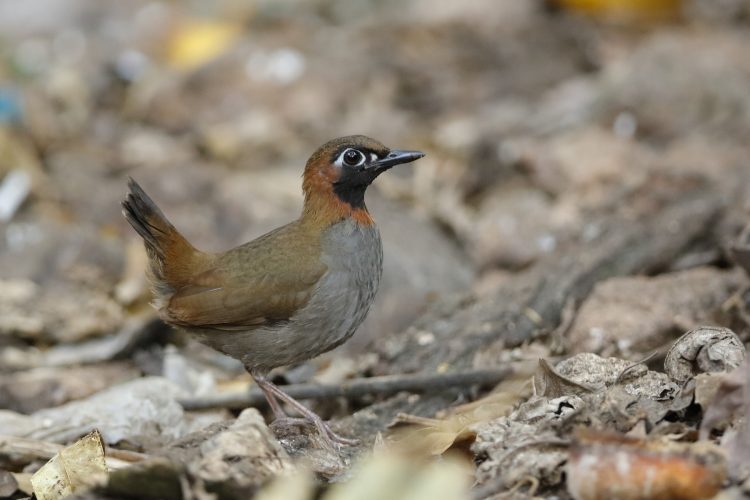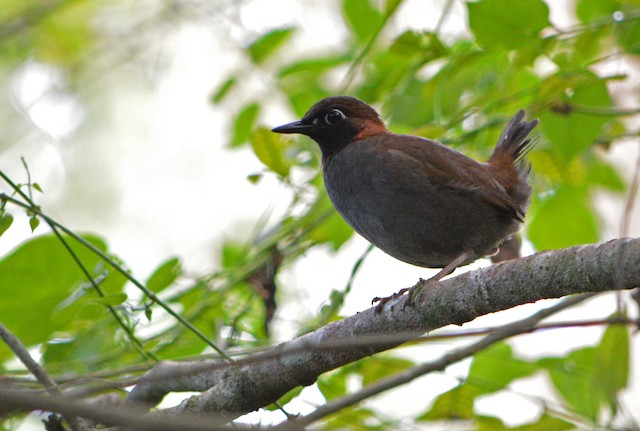Page Contents
Introduction
The genus Formicarius comprises 5 widely recognized species of terrestrial, crake-like antbirds of Neotropical forests. It is considered that Black-faced Mayan Antthrush “Formicarius analis” is a single species whose range extends from south-eastern Mexico to South America. It is also recognizing three subspecies groups within F. analis: the moniliger Mexican Antthrush group ranging from south-eastern Mexico to northern Honduras.
The hoffmanni Hoffmann’s Antthrush group from eastern Honduras to Colombia, northern Venezuela, and Trinidad. The analis Black-faced Mayan Antthrush group from south-eastern Colombia and southern Venezuela to Amazonian Brazil. These groups are distinguished primarily by plumage differences.
Therefore, particularly the extent of rufous on the chest and the sides of the neck,. Observers with field experience in Middle America immediately recognized that the song of black-faced antthrushes from Mexico, Guatemala, and Belize sounds quite different from their song in southern Central America.
These northern birds are a full species, Mexican Antthrush F. moniliger, but this split was ignored by AOU1. That “more than one species may be involved” and that birds in northern Middle America differ morphologically and vocally from birds in southern Middle America. However, the Middle American black-faced ant thrushes as two allopatric species. It explains more fully the characters of the Mexican Antthrush “F.moniliger”, and also highlights a problem within this complex in South America that needs further study.

Voice / Song / Sound
The song of F. moniliger is a single whistle followed after a relatively short pause by a rapid series of 8 to 12 evenly paced whistles and may be as piu,piupiupiupiupiupiupiupiu…, or “keee-cu-cu-cu-cu.” All sounds are on a similar pitch, although the last notes of the series may be slightly lower or higher than the first ones.
However, the introductory note is the longest, and notes in the rapid series are all about the same length, with the later notes tending to be sharply down-slurred in This particular song is throughout the range of the Mexican Antthrush from Veracruz, Mexico, to northern Honduras. The song in Nicaragua, Costa Rica, Panama, and the middle Magdalena Valley is a single whistle followed typically by 2 to 4 (rarely up to 13) slow-paced whistles, pee, piu piu, or “per—pur-pur” or “keep two.”.
The song is described as plaintive and deliberate, likening it to the song of Chestnut-backed Antbird of Nicaragua, and south through Ecuador. A comparison that would not be evoked with moniliger. The introductory song is slightly higher, with the subsequent calls at an even pitch or with a slight overall decrease from first to last.
All songs are about the same length or sometimes decrease slightly in length between the first and last. Hence, the calls of the second part of the song are obviously longer than those of moniliger, as are the spaces between the notes. The song of black-faced mayan antthrushes in most of South America, from western Venezuela, Trinidad, eastern Ecuador, and eastern Peru through Amazonia, superficially suggests moniliger, and is quite unlike the hoffmanni group.
It consists of a single, longer whistle followed after a relatively long pause by 3 to 15 short, fast-paced whistles in descending series. Which is transcribed as whiipiipiipiipiipiipiipiipiipiipiipii (Ecuador), or whiiu di-di-di (Trinidad). In longer series, the earlier sounds are short and arched, grading into the longer, more level later notes.

The effect on the human ear is that the series starts abruptly with a rippling, melodic quality that descends into slurred notes at the end, quite unlike the evenly paced, flatter-sounding song of moniliger. Based on a limited number of tape recordings, northern birds appear to give fewer notes than southern birds in the second part of the song. 3 to 4 notes in Trinidad, 5 to 11 in Venezuela, and 8 to 15 in Ecuador and Peru.
Thus, there are three distinct song types in “F. analis”: Mexico to northern Honduras, Nicaragua to Panama; and South America. The abrupt break in northern song-type equates to the major biogeographic division centered on the Sula Valley and the interior of Honduras. Moreover, it has also found no specific description of the song of black-faced Antthrushes from eastern Honduras, but predicts. That it is the same as that of morphologically identical birds in adjacent Nicaragua.
Also, during fieldwork in the lowland rainforests of eastern Honduras, they did not note Formicarius songs different from those he was familiar with from Nicaragua. Since birds in eastern Panama, on the Colombian border, have songs typical of the Hoffmann group, the southern shift in voice can be expected to occur in northern Colombia and north-western Venezuela, perhaps between the north-western and eastern slopes of the Andes.
Plumage
All black-faced antthrushes have a black face and throat, which offset a naked, pale blue orbital ring. Their upperparts are overall rich dark brown, and their underparts are smoky grey. All three subspecies of F. moniliger (pallidus, intermedius, and nominate moniliger) differ consistently from other black-faced antthrushes in their rufous-chestnut fore collar below the black throat.
The hoffmanni and analis groups lack this fore-collar, so that the black throat is sharply defined and abuts the gray chest. Other differences between F. moniliger intermedius of central Honduras and the subspecies umbrosus of eastern Honduras are the darker underparts and more vinaceous, less chestnut neck sides of the latter.
Thus, a marked change in the plumage of black-faced antthrushes parallels the break-in song type in eastern Honduras. The situation in South America, however, is less clear-cut, since the break-in plumage between birds with rufous neck sides and those with clay-colored neck sides occurs in southern Colombia and southern Venezuela.
Thus, birds in Trinidad and northern Venezuela have been aligned by plumage with the hoffmanni group of southern Central America. While their songs align them with the Amazonian analis group,. Interestingly, this problem suggests that it is found in Microcerculus wrens, where song change parallels plumage change in Central America but in South America, song and plumage breaks do not correlate.

Habitat
The Formicarius antthrushes of Middle America inhabit the floor of a humid forest. The Mexican Antthrush F.moniliger occurs in humid evergreen to semi-deciduous forest from sea level to 1,800 m elevation from central Veracruz, Mexico, through Belize and Guatemala to northern and central Honduras.
In Mexico and Guatemala, F. moniliger is as typical of cloud-forest as of rainforest and its center of abundance in Honduras is the mid-elevation humid forests from 400 to1,200 m. The hoffmanni group of southern Central America occurs in humid evergreen to semi-deciduous forests, mainly below 900m. Although it reaches 1,500 m locally in Costa Rica,.
In Honduras, a specimen of this form was collected along the Río Guampú (about 430 m elevation) in the Olancho rainforests. This specimen “is typical in every way of the southern Central American race, F.a. umbrosus oddly, no other Honduran specimen, not even those from El Boquerón, about 60 km south-west, shows any approach to umbrosus.
Where the ranges of the two species approach, F. moniliger appears to be a bird of the foothills and is replaced in the lowlands by the hoffmanni group. Altitudinal replacement is the rule among Formicarius species in southern Central America and South America, e.g., F. analis (hoffmanni group), F. nigricapillus and F.rufipectus in Costa Rica.
Summary:
The sharp break in voice and plumage combined with apparent altitudinal replacement of Formicarius antthrushes in eastern Honduras. That indicates that the northern birds should be recognized as a separate species, F. moniliger, the Mexican Antthrush.
Differences in head and chest pattern, combined with song, are also the main specific features of other Formicarius antthrushes. The song differences between moniligerand other black-faced antthrushes are comparable to accepted species-level differences in the genus Formicarius although the Black-faced Antthrush complex constitutes a single superspecies.
Comparably striking differences in song type exist between birds in southern Central America and those in most of South America. While two subspecies groups, hoffmanni, and analis, have been recognized in this range,. These are based on plumage differences, which, interestingly, do not correlate with the shift in song type. Ornithologists active in Colombia and Venezuela should determine where the shift in song type occurs, and how it may be correlated with plumage, morphology, or habitat.
Read More – White-winged Dove
